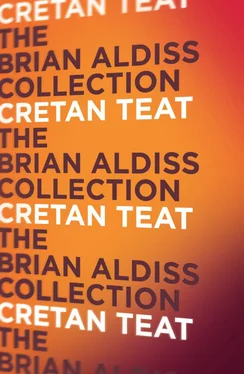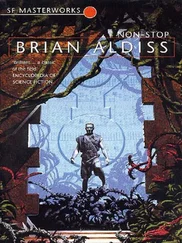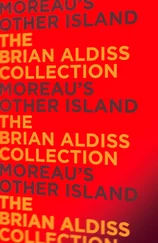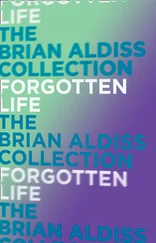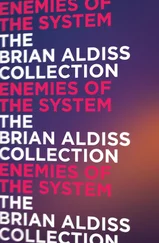Cretan Teat
BY BRIAN ALDISS

Title Page Cretan Teat BY BRIAN ALDISS
Introduction
Epigraph ‘Where the bee sucks, there suck I …’ Shakespeare, The Tempest
Chapter One
Chapter Two
Chapter Three
Chapter Four
Chapter Five
Chapter Six
Chapter Seven
Chapter Eight
About the Author
By the same author from The Friday Project
Copyright
About the Publisher
Introduction Contents Title Page Cretan Teat BY BRIAN ALDISS Introduction Epigraph ‘Where the bee sucks, there suck I …’ Shakespeare, The Tempest Chapter One Chapter Two Chapter Three Chapter Four Chapter Five Chapter Six Chapter Seven Chapter Eight About the Author By the same author from The Friday Project Copyright About the Publisher
Yes, I went to Crete. And I came back.
How exciting was everything involved with Cretan Teat . If you happen to ask yourself why so few copies of this gorgeous novel have sold, well, read on. We shall come to that in a minute.
It was a new century and I decided to take Charlotte, my youngest daughter, with me to south Crete, in the mistaken belief that we could swim in the warm seas off the coast. But, simply plunging our naked feet into the tide was sufficient to disabuse us of that illusion. The Eastern Mediterranean had a message for us: ‘Stay out!’
We went and had a drink instead, and studied our learning curve. The island was alive with such curves. We found that Crete had suffered a chequered history ever since the collapse of Constantinople. It had been prosperous under Greece, but was now – as was also the case with my daughter and me – a touch run down.
One day, I wandered through a forest of ancient trees, evidently designed by Arthur Rackham. There I found myself lost and came upon a small chapel, I felt, long ago abandoned by the family who had built it. I managed to get inside. In fresco on the wall was the portrait of a woman feeding what was evidently an infant Christ. The woman looked old and bore a halo. Not Mary, mother of Jesus. Back in the town, I sought out the village priest for information. (Ah, the thirst for information! The fuel driving a writer’s engine!) The priest was sitting on a chair in his garden. He said we could not go inside; his wife was repainting the whole house from top to bottom. This either pleased or irritated him; it was hard to tell. He told me that the woman in the fresco was Sveti Anna, Christ’s grandmother. Mary, being a virgin, he explained, had run out of milk.
On the seafront, facing the cold grey ocean, was a family coffee shop. The daughter there served coffee to customers. When not thus engaged, she sat at a tiny desk behind the glass door, studying and painting in a Byzantine manner. I gave her a photo I had taken of St Anna, asking her to copy it in the Byzantine style. She said she could do it in a week – at which time, Charlotte and I would be gone.
I paid the young lady on the spot and received the painting when back in Oxford, it was to be the cover for the novel already brewing in my mind. You see, we trusted each other. The lady now lives happily in Athens, skilfully painting fakes for tourists in the Byzantine fashion. It seems that this story of St Anna is little known in the West. Her coffin lies in the East, in Hagia Sophia, in Istanbul.
A branch of the story I found myself likely to tell, lay beyond religion, in the grey alleyways and streets of ancient Kyriotisa.
Here, Hitler’s forces in World War Two had invaded the town. Mothers and their children had been shut into the church and the church set on fire.
Here was a terrible story that had become wedged into the minds of the following generation, a story that was the antithesis of the Anna mother-care tale. Wherever one went, into garages, or food shops, or restaurants, or simple bars, there would be someone bleak of face to tell you about German war crimes.
I grew weary of their old song. I found myself asking: ‘after the war, did not Konrad Adenauer himself come to apologise for Nazi atrocities? Why, German workers arrived and rebuilt the church and mended the roads …’ And the waiter or waitress or whoever it was would ask scornfully, ‘Why do you defend such villains?’
So there I was with my two sides of a story. What I wanted to add was something of the sexuality that happens when one is young – or not so young – and on holiday. Once we were home, I wrote my novel. A new company, Stratus, had just bought up fourteen of my past books; it seemed only civil to offer them my Cretan Teat . They accepted it.
So this is where we came in, as people used to say in cinemas running continuous programmes. The reason why this gorgeous and provocative novel sold so few copies, found so few readers, was because The House of Stratus in Old Burlington Street, London, was going bust.
My faithful editor at Stratus worked on, although she had been sacked. It was she who got it into book form complete with that cover and all. Meanwhile the ‘Titanic’ was fast going under. There was no distribution. Only the angry seas.
What you are now holding is virtually a new book …
Brian Aldiss
Oxford, 2014
‘Where the bee sucks, there suck I …’
Shakespeare, The Tempest
Конец ознакомительного фрагмента.
Текст предоставлен ООО «ЛитРес».
Прочитайте эту книгу целиком, купив полную легальную версию на ЛитРес.
Безопасно оплатить книгу можно банковской картой Visa, MasterCard, Maestro, со счета мобильного телефона, с платежного терминала, в салоне МТС или Связной, через PayPal, WebMoney, Яндекс.Деньги, QIWI Кошелек, бонусными картами или другим удобным Вам способом.
